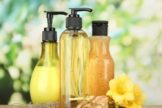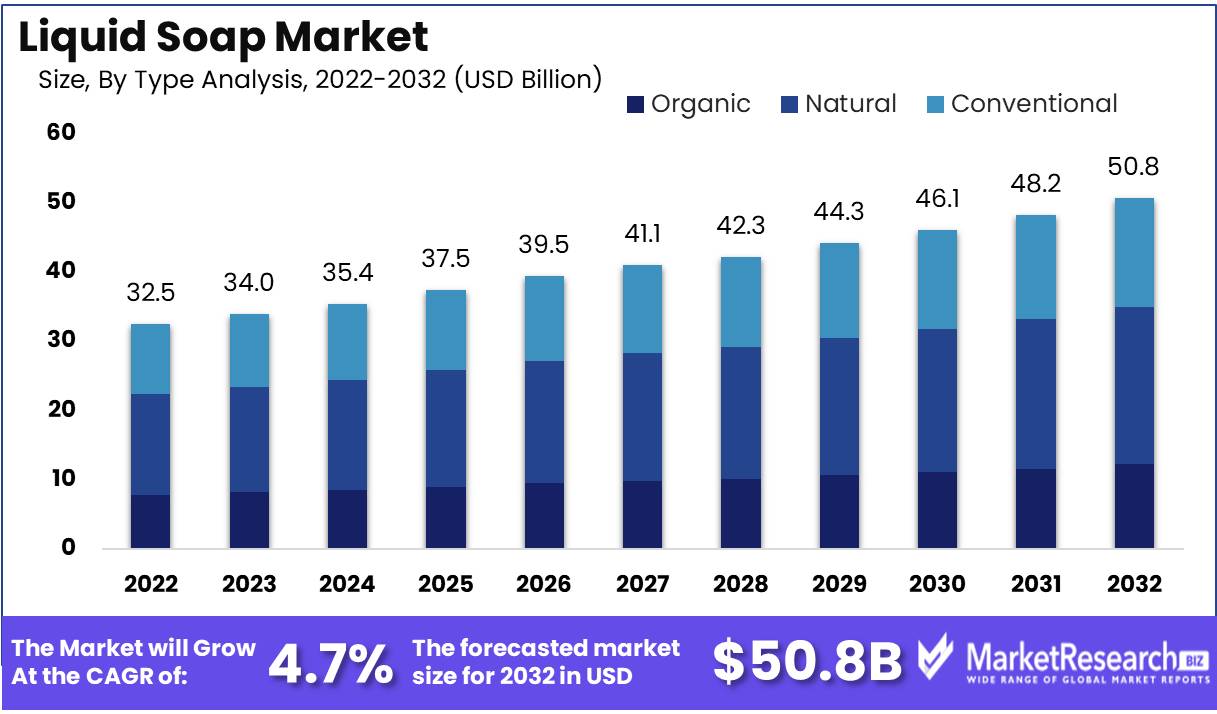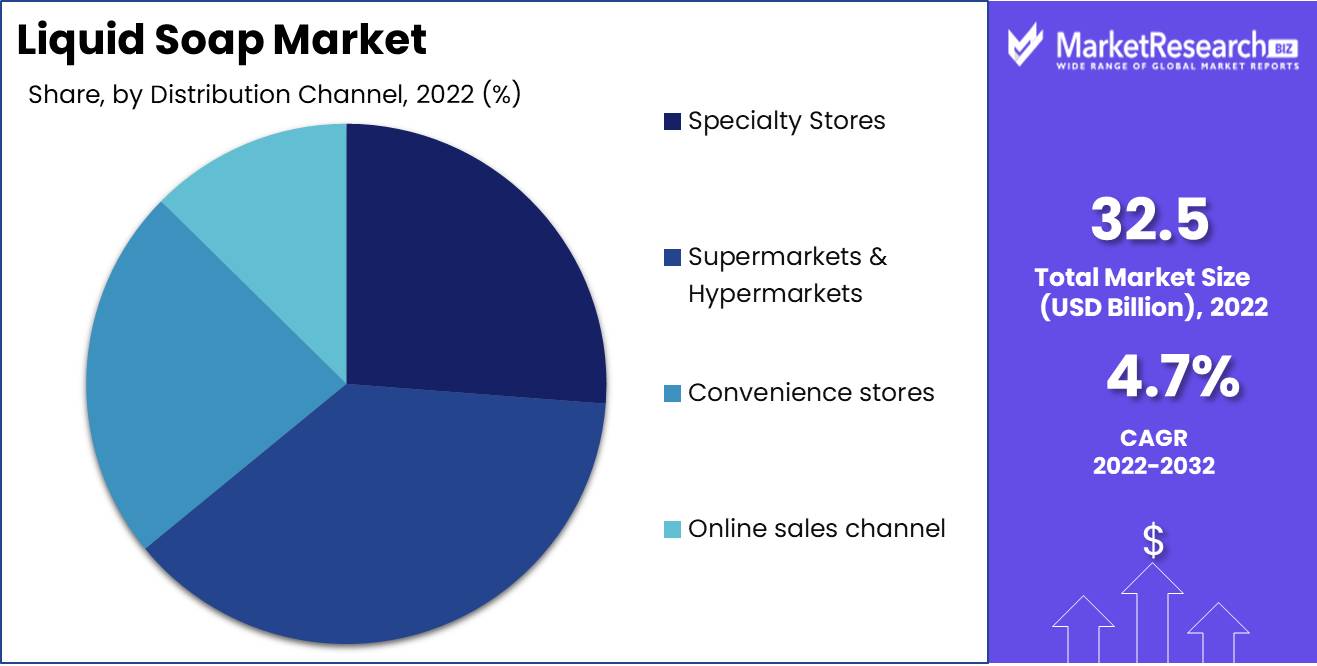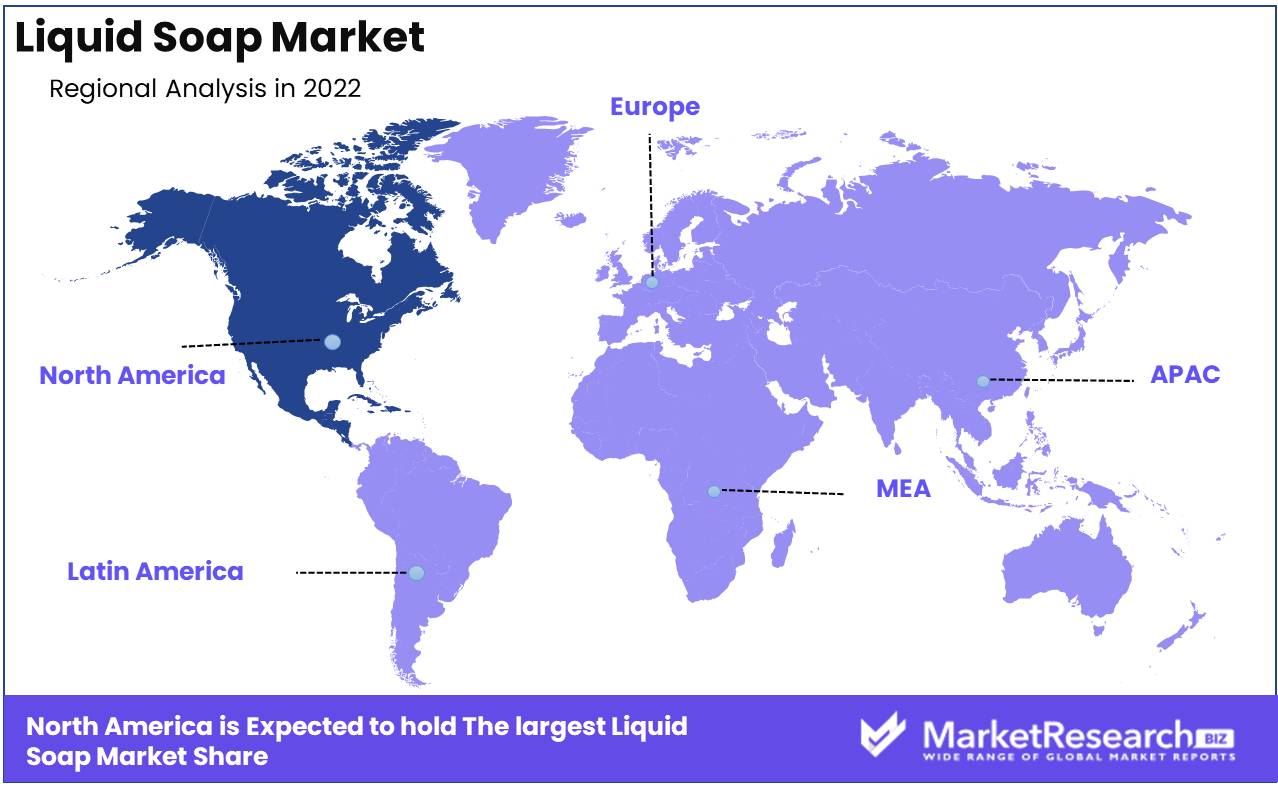
Liquid Soap Market By Type Analysis (Organic, Natural, Conventional), By Application Analysis (Commercial , Residential), By Distribution Channel Analysis (Specialty Stores, Supermarkets & Hypermarkets , Other), By Region And Companies - Industry Segment Outlook, Market Assessment, Competition Scenario, Trends, And Forecast 2023-2032
-
12116
-
May 2023
-
151
-
-
This report was compiled by Research Team Research team of over 50 passionate professionals leverages advanced research methodologies and analytical expertise to deliver insightful, data-driven market intelligence that empowers businesses across diverse industries to make strategic, well-informed Correspondence Research Team Linkedin | Detailed Market research Methodology Our methodology involves a mix of primary research, including interviews with leading mental health experts, and secondary research from reputable medical journals and databases. View Detailed Methodology Page
-
Quick Navigation
Report Overview
Liquid Soap Market size is expected to be worth around USD 50.8 Bn by 2032 from USD 32.5 Bn in 2022, growing at a CAGR of 4.7% during the forecast period from 2023 to 2032.
A small portion of the vast personal hygiene market, which includes shampoo, body wash, and hand sanitizers, is occupied by the realm of liquid soap. Liquid soap, a remarkably inventive soap formulation created for the noble purposes of maintaining hand and body hygiene, takes the form of a fluid substance, making it easy to apply and rinse away.

Behold the elevated ambitions of the liquid soap market, which is unceasing in its pursuit of providing consumers with an effective means of achieving impeccable hand and body hygiene, a mission characterized by convenience and usability. Its essence lies in the art of forging a product that not only possesses formidable efficacy but also brims with consummate efficiency, ensuring that users derive the greatest possible benefit from its use.
In the maze-like landscape of the liquid soap market, one innovation shines with brilliant brilliance: the advent of effervescent liquid soap. This audacious variant of liquid soap offers a veritable plethora of benefits, resembling its traditional liquid counterpart while also harnessing the sublime ability to generate opulent lather, thereby enhancing its efficacy in removing stubborn grime and unsightly oils from the skin.
With the passage of time, the liquid soap market has become a mesmerizing oasis, attracting torrents of investment from a myriad of companies, each of which seeks to leave its imprint. In recent years, countless personal hygiene brands have adopted the liquid soap revolution, adorning their product portfolios with hand and body hygiene solutions of their own design and even deftly incorporating liquid soap into the very composition of hand sanitizers and household cleaning agents.
The inexorable growth of this burgeoning market can be attributed to an increase in demand for personal hygiene products, the tantalizing availability of a myriad of enticing varieties, and the advent of environmentally conscious, nature-embracing alternatives that resonate harmoniously with the organic-loving public.
The primary beneficiaries of the liquid soap market can be found within the personal hygiene industry, specifically the sanctuaries of hand and body hygiene. As the insatiable demand for personal hygiene products continues to grow, companies are compelled to expand the scope of their product lines, incorporating liquid soap into their illustrious domains.
The dynamic forces that propel the liquid soap market forward can be reduced to a handful of fundamental forces. The escalating demand for personal hygiene products, the advent of environmentally responsible and organic alternatives, and the undeniable appeal of liquid soap's convenience and ease of use, a notable departure from the time-honored realm of traditional bar soap, are chief among these factors.
As with all personal hygiene consumables, the liquid soap market faces a plethora of ethical dilemmas, the most prominent of which involve the product's responsible employment and disposal. Companies operating in this ethereal realm have an unwavering commitment to transparency, detailing the interior workings of their production processes and forging a steadfast path toward accountability and clarification.
Driving factors
Demand for Natural Liquid Soaps is Growing
One such factor is a rise in sanitation and cleanliness awareness among consumers. The demand for hygienic and natural detergent products has increased as consumers become more conscious of their personal hygiene. This has led to a growing demand for natural and eco-friendly liquid detergents.
Convenience and Selection Drive the Market for Liquid Soap
The increasing availability of liquid soaps in a variety of fragrances and sizes is another factor contributing to the growth of the liquid soap market. Liquid soap is now a popular alternative to traditional bar soap thanks to advances in packaging technology that have also led to ease of use and convenience. In addition, the hospitality and healthcare industries have a growing demand for luxury and premium liquid detergents.
Urbanization Increases Sales of Liquid Soap
The increase in the use of liquid soap for personal hygiene is another significant factor propelling the growth of the liquid soap market. Increasing urbanization and a shift in lifestyle habits have fueled the demand for liquid detergent products even further. This has led to the availability of an extensive selection of liquid detergent products at reasonable prices.
Regulatory Changes Influence the Market for Liquid Soap
Existing or prospective regulatory changes may have an impact on the liquid soap market. Many nations have implemented restrictions on the use of specific chemicals in detergent products. For instance, REACH restricts the use of certain chemicals in detergent products.
Technological Progresses Shape the Liquid Soap Industry
Emerging technologies, such as sophisticated mixing and blending techniques, may have a future impact on the liquid soap market. In addition, potential disruptors, such as new entrants and innovative products, may impact the competitive landscape of the liquid detergent market.
Increasing Demand for Eco-Friendly Liquid Soaps
Consumer behavior is constantly evolving, and emerging trends may have an impact on the market for liquid detergent. For example, consumers are becoming more conscious of ethical and environmentally friendly products. Consequently, there is a growing demand for natural and eco-friendly detergent products.
Restraining Factors
Raw Material Price Volatility Dilemma
High competition among established competitors is one of the main restraining factors in the liquid soap market. This competition results in a price war that has a negative impact on profitability and long-term viability. As more brands penetrate the market, price-based competition becomes increasingly difficult. To combat this, companies must differentiate their products through the use of novel characteristics, attractive packaging, and strategic marketing campaigns.
Confronting Counterfeit Dangers in Liquid Soap
The volatility of raw material prices is an additional factor restraining the liquid soap market. The cost of basic materials, including oils, fragrances, and preservatives, can fluctuate based on supply and demand, seasonal fluctuations, and other external factors. This circumstance makes it difficult to calculate and predict production costs, making it difficult to appropriately price liquid soap products.
Cheaper Substitutes Impact Liquid Soap
Genuine liquid soap sales are severely threatened by counterfeit products. As the demand for liquid soap products rises, unscrupulous people and companies attempt to take advantage of the market by manufacturing and selling counterfeit liquid soap that resembles authentic versions but is manufactured with inferior materials. The impact of counterfeiting is felt in terms of both lost revenues for legitimate actors and potential health risks posed by substandard products.
Sustainable Packaging Is Expensive Due to Environmental Pressures
The availability of inexpensive substitutes is another significant factor restraining the market for liquid soap. With the increase in competition, lesser players may be able to produce products at a lower cost than larger brands cannot match. These less expensive substitutes frequently have disadvantages, such as inferior ingredients and substandard performance. Nevertheless, these factors do not deter some consumers who are prepared to pay less for inexpensive substitutes.
Cost-Effectiveness Analysis of Liquid Soap
The use of liquid soap products necessitates the proper disposal of packaging materials. Manufacturers are under pressure to use biodegradable or recyclable packaging materials as a result of the growing environmental consciousness, particularly in developed nations. While such packaging materials can be eco-friendly, they are also costly to manufacture, which can increase the ultimate price of the product.
Type Analysis
The world is experiencing a transition toward natural products, and the market for liquid soap reflects this trend. The Natural Segment dominates the liquid soap market, and its dominance is expected to persist in the future years. This market segment is driven by consumer demand and heightened awareness of the advantages of using natural products.
The adoption of the Natural Segment is driven by the accelerating economic growth of emerging economies. As their purchasing power increases, consumers in these regions are more prepared to pay a premium for natural products as they become more informed about their benefits.
The increasing health consciousness and environmental consciousness of consumers is reflected in their purchasing decisions. They are more willing to pay a premium for natural, sustainable products that are free of hazardous chemicals. As a consequence, the Natural Segment is anticipated to expand rapidly.
In the coming years, the Natural Segment of the liquid soap market is anticipated to record the highest growth rate. This expansion can be attributed to the growing demand for natural products brought on by a shift in consumer preferences.
Application Analysis
The Commercial Segment dominates the liquid soap market, and its growth is anticipated to continue over the next few years. Demand from industries such as hospitality, healthcare, and food processing drives the Commercial Segment.
Commercial Segment adoption is driven by the economic development of emerging economies. As these economies develop, the demand for commercial spaces such as hotels and restaurants increases, which drives the demand for commercial liquid soap.
Consumers in the hospitality, healthcare, and food processing industries demand liquid soaps of superior quality that meet their specific requirements. They are searching for antimicrobial products that are effective and gentle on the skin.
Over the future years, it is anticipated that the Commercial Segment of the Liquid Soap Market will experience the fastest growth rate. The expansion is attributable to rising demand from the hospitality, healthcare, and food processing industries, as well as the rising demand for high-quality liquid soap products.
Distribution Channel Analysis
The Supermarkets/Hypermarkets Segment dominates the liquid soap market, and its dominance is anticipated to persist in the coming years. Supermarkets and hypermarkets provide an extensive and convenient selection of liquid soap products.
The adoption of the Supermarkets/Hypermarkets Segment is driven by economic growth in emerging economies. As these economies expand, the demand for retail spaces, such as supermarkets and hypermarkets, rises, thereby driving the demand for liquid soap products.
Due to their convenience and extensive product selection, supermarkets and hypermarkets are gaining popularity with consumers. Liquid soap is a fixture in these stores, and consumers prefer to purchase liquid soap from these establishments.
In the liquid soap market, it is anticipated that the supermarket/Hypermarkets Segment will experience the highest growth rate in the future years. The development is attributable to the rising demand for liquid soap products in supermarkets and superstores.

Key Market Segments
Type Analysis
- Organic
- Natural
- Conventional
Application Analysis
- Commercial
- Residential
Distribution Channel Analysis
- Specialty Stores
- Supermarkets & Hypermarkets
- Convenience stores
- Online sales channel
Growth Opportunity
The Extreme Growth of Organic Liquid Soaps
As consumers become more aware of what they put on their epidermis, the demand for organic and natural liquid soaps increases. In terms of popularity, liquid soaps have surpassed bar soaps due to their convenience, adaptability, and ease of use. This shift in consumer preferences, coupled with the growth of online shopping for consumer goods and the emergence of new market players offering innovative and specialized liquid soap products, presents an expansion opportunity for the liquid soap market.
Convenience Fuels Liquid Soap Boom
In recent years, the wellness industry has grown substantially, with an increasing number of consumers opting for natural and organic hygiene products. Manufacturers of liquid soap have responded to this trend by creating organic and natural liquid soaps devoid of hazardous chemicals and preservatives. Organic and natural liquid soaps offer numerous benefits to consumers, including gentle and effective cleansing, nourishment, and anti-inflammatory properties. Ideal for individuals with sensitive skin, allergies, or dermatological conditions.
The Development of Liquid Eco-Friendly Soap
Leading brands of organic and natural liquid soap incorporate eco-friendly ingredients and packaging into their products. Due to these practices, customers associate these brands with environmentally responsible consumption. Online shopping has revolutionized the way consumers purchase products, including liquid soaps. With e-commerce platforms offering rapid, dependable, and affordable shipping, it has become increasingly advantageous for consumers to buy liquid soaps online.
Online, Specialty Players Do Well
The ease of online shopping has created new markets and provided niche actors with the opportunity to market their specialized products to a larger audience. Innovative liquid soap products, such as those with exotic fragrances, customized formulations, and distinctive packaging, are now available to a global consumer base thanks to e-commerce platforms. In emerging economies, the growth of the hospitality and healthcare industries has increased the demand for liquid soaps in bulk.
Innovative Packaging Solutions
Manufacturers of liquid soap are implementing innovative and sustainable packaging solutions, such as recyclable bottles, biodegradable pouches, and paper-based packaging, in order to meet the rising demand for eco-friendly products among consumers. New market participants have entered the liquid soap market, bringing with them innovative and specialized products that meet the specific needs of consumers.
Latest Trends
The Emergence of Multi-Purpose Liquid Soaps
As the world becomes more health-conscious and focused on eco-friendly and sustainable products, the market for liquid detergent has undergone significant transformations. The industry is experiencing a number of trends that are reshaping the market and influencing how consumers use and select liquid detergent products.
Eco-friendly Liquid Soap Boom
Consumers are becoming more and more interested in multi-functional liquid soaps. These products feature moisturizing, anti-bacterial, anti-viral, and aromatherapeutic properties. As a result of the COVID-19 pandemic, the demand for anti-bacterial products has skyrocketed, and multi-purpose liquid soaps have become a necessity in many homes.
Innovative Packaging Techniques
Consumers are now more conscious of how their purchases affect the environment, and this trend is increasingly influencing their selection of liquid detergent products. In recent years, plant-based liquid soap products made from natural ingredients have acquired significant popularity. These products are eco-friendly, biodegradable, and chemical-free, making them safer for the environment and the epidermis of consumers.
Unique Fragrances Transform Liquid Soaps
Packaging plays a crucial function in the market for liquid soap. Consumers are attracted to products that are aesthetically pleasing and easy to use. Consequently, the market is observing packaging innovations that enhance the product's appeal. Some liquid soap products, for instance, are now packaged in bottles with pumps, making it simpler to dispense the product with one hand.
Increasing Interest in Eco-Friendly Liquid Soaps
To stand out in a competitive market, manufacturers of liquid detergent are increasingly focusing on product differentiation. Unique fragrances and ingredients are gaining popularity as a means to distinguish oneself in the marketplace. For instance, some liquid detergent products now contain essential oils such as lavender, peppermint, or rosemary. In addition to providing a pleasant experience, these unique fragrances also provide additional benefits such as relaxation, tension relief, and skin nourishment.
Regional Analysis
Natural and organic liquid soap products have grown significantly in North America during the past few years. Demand for natural and organic personal care products has increased as people become more conscious of what they put on their skin. Natural and organic liquid soap products meet consumer needs for safer and better hygiene options.
Several reasons are driving North American demand for natural and organic liquid soap products. First, people are more aware of how synthetic chemicals and harsh ingredients affect their skin. Thus, they seek gentler, safer options that don't irritate the skin, create allergies, or disrupt hormones.
Second, consumers are becoming more environmentally conscious of personal care products. Biodegradable and sustainable ingredients are used in natural and organic liquid soap products. This makes them appealing to carbon-conscious people.
Finally, small, local firms that make natural and organic products are gaining popularity. Handmade, sustainable, and locally sourced products give customers a more customized experience.
The fact that they are manufactured from premium ingredients without synthetic chemicals like parabens or SLS is one of the biggest benefits of natural and organic liquid soap products. These chemicals can irritate the skin and harm health. Natural and organic liquid soap products are safer and healthier.

Key Regions and Countries
North America
- US
- Canada
- Mexico
Western Europe
- Germany
- France
- The UK
- Spain
- Italy
- Portugal
- Ireland
- Austria
- Switzerland
- Benelux
- Nordic
- Rest of Western Europe
Eastern Europe
- Russia
- Poland
- The Czech Republic
- Greece
- Rest of Eastern Europe
APAC
- China
- Japan
- South Korea
- India
- Australia & New Zealand
- Indonesia
- Malaysia
- Philippines
- Singapore
- Thailand
- Vietnam
- Rest of APAC
Latin America
- Brazil
- Colombia
- Chile
- Argentina
- Costa Rica
- Rest of Latin America
Middle East & Africa
- Algeria
- Egypt
- Israel
- Kuwait
- Nigeria
- Saudi Arabia
- South Africa
- Turkey
- United Arab Emirates
- Rest of MEA
Key Players Analysis
As more players enter the liquid soap market with novel ideas and new product offers, the industry has become more competitive. Procter & Gamble, Unilever, and Colgate-Palmolive are key market players.
Procter & Gamble's Ivory is one of the top players in the liquid soap market. The company has been in business for decades and is trusted in the industry. Unilever is a key player with Dove, Lux, and Lifebuoy.
Johnson & Johnson, Reckitt Benckiser, and Henkel are also market players. These companies have a large market share and compete with new and existing players. Seventh Generation and Mrs. Meyers, smaller companies that specialize in eco-friendly and sustainable products, have also become industry leaders.
Rising hygiene and sanitation awareness and consumer preference for liquid soaps over bar soaps will drive the liquid soap market. To keep ahead of the competition and match client requests, key market players must innovate. Companies that can include eco-friendly and sustainable characteristics in their liquid soap offerings will succeed.
Top Key Players in Liquid Soap Market
- Premier English Manufacturing Ltd.
- Procter & Gamble
- Unilever
- Cleenol Group Ltd.
- Christina May Ltd.
- Reckitt Benckiser Group plc
- GlaxoSmithKline
- Unilever
- LES ROBINETS PRESTO S.A.
- Colgate-Palmolive Company
- Henkel Corporation
Recent Development
- In 2021, Unilever pledged to make all of its plastic packaging, including liquid soap packaging, recyclable, reusable, or compostable by 2025.
- In 2020, Johnson & Johnson Consumer Health launched a new line of liquid hand soaps under the Aveeno brand name.
- In 2019, Procter & Gamble launched "Microban 24 Hour," a new line of liquid soap hand products.
- In 2018, Method Products launched a line of foaming hand washes made from plant-based ingredients and packaged in bottles made from ocean plastic.
- In 2017, Colgate-Palmolive launched "Softsoap Earth Blends," a new line of liquid soap hand products.
Report Scope:
Report Features Description Market Value (2022) USD 32.5 Bn Forecast Revenue (2032) USD 50.8 Bn CAGR (2023-2032) 4.7% Base Year for Estimation 2022 Historic Period 2016-2022 Forecast Period 2023-2032 Report Coverage Revenue Forecast, Market Dynamics, COVID-19 Impact, Competitive Landscape, Recent Developments Segments Covered By Type Analysis (Organic, Natural, Conventional), By Application Analysis (Commercial, Residential), By Distribution Channel Analysis (Specialty Stores, Supermarkets & Hypermarkets, Convenience stores, Online sales channel) Regional Analysis North America – The US, Canada, & Mexico; Western Europe – Germany, France, The UK, Spain, Italy, Portugal, Ireland, Austria, Switzerland, Benelux, Nordic, & Rest of Western Europe; Eastern Europe – Russia, Poland, The Czech Republic, Greece, & Rest of Eastern Europe; APAC – China, Japan, South Korea, India, Australia & New Zealand, Indonesia, Malaysia, Philippines, Singapore, Thailand, Vietnam, & Rest of APAC; Latin America – Brazil, Colombia, Chile, Argentina, Costa Rica, & Rest of Latin America; Middle East & Africa – Algeria, Egypt, Israel, Kuwait, Nigeria, Saudi Arabia, South Africa, Turkey, United Arab Emirates, & Rest of MEA Competitive Landscape Premier English Manufacturing Ltd., Procter & Gamble, Unilever, Cleenol Group Ltd., Christina May Ltd., Reckitt Benckiser Group plc, GlaxoSmithKline, Unilever, LES ROBINETS PRESTO S.A., Colgate-Palmolive Company, Henkel Corporation Customization Scope Customization for segments, region/country-level will be provided. Moreover, additional customization can be done based on the requirements. Purchase Options We have three licenses to opt for: Single User License, Multi-User License (Up to 5 Users), Corporate Use License (Unlimited User and Printable PDF) -
-
- Premier English Manufacturing Ltd.
- Procter & Gamble
- Unilever
- Cleenol Group Ltd.
- Christina May Ltd.
- Reckitt Benckiser Group plc
- GlaxoSmithKline
- Unilever
- LES ROBINETS PRESTO S.A.
- Colgate-Palmolive Company
- Henkel Corporation




